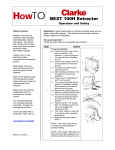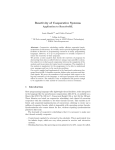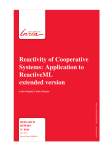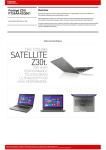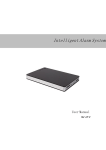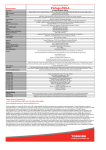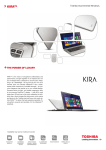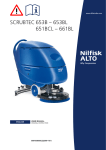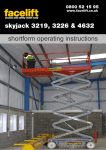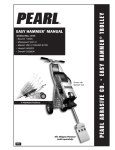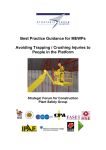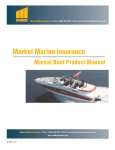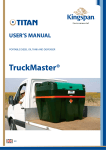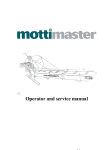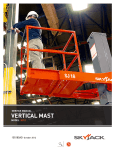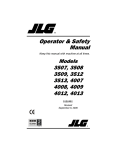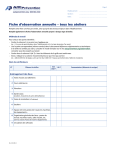Download Owner`s Manual.qxd - Tate Access Floors
Transcript
Laminated Porcelain Panel Owner’s Manual 1 Table of Contents I. Care and Use of the Tate Access Floor System Site Conditions 1 Performance Criteria 1 Construction Phase 2 Equipment Moving Precautions 2 Approved Lifts 2 Removal and Reinstallation 3 II. Panel Cutting Procedures Factory Cutouts Safety Requirements Field Cuts Supporting a Cut Panel 4 4 4 4 III. Cleaning & Maintenance Initial Pre-Occupancy & Preparation Guidelines Regular Maintenance 6 IV. Additional Resources 6 6 Care & Use of the Tate Access Floor System Laminated with Unglazed Porcelain Tile Access floor systems are supplied and installed in conformance with the requirements set forth by individual project specifications and approved submittal documents. It is important to clearly understand the design capabilities of the Tate access floor system as installed in specific projects. Site Conditions Area to receive and store access floor materials shall be enclosed and maintained at ambient temperatures between 35 to 95 F and relative humidity levels between 20 to 80%. At least 24 hrs. before installation begins, all floor panels shall be stored at ambient temperatures between 50 to 90 F and relative humidity levels between 20% to 80% and shall remain within these environmental limits throughout occupancy. Performance Criteria Access floor panels laminated with porcelain tile require a minimum panel rating of a ConCore 1500. Due to the nature of the porcelain, the performance rating of the panels will be as follows: Design load – 1000 lbs. when tested on bolted stringer understructure using CISCA test methods (with loads applied through a 1” indentor at the weakest point) Ultimate load – 1600 lbs. when tested on bolted stringer understructure using CISCA test methods (with loads applied through a 1” indentor at the weakest point). Ultimate load is the point at which the tile cracks, not failure of the panel Dynamic loads: o 10 pass using a 3” diameter x 1-13/16” wide rubber wheel – 800 lbs. o 10,000 pass using a 6” diameter x 2” wide urethane wheel – 600 lbs. Impact loads – Impact loads should always be avoided as they will damage or crack the porcelain * The above criteria must be complied with or damage to the tile will occur. Please contact an authorized Tate dealer or call the Tate Technical Hotline at 1-800-231-7788 for procedures to follow when wheel sizes and loads differ from those identified in Tate product specifications. 1 Construction Phase During the construction and move in phase, a minimum of 3/4” plywood must be used to protect the floor, without exception. All materials and equipment used by other trades must be reviewed and approved by the Tate dealer/installer prior to the material or equipment being permitted on the floor. Equipment Moving Precautions The access floor must be protected from overloads and circumstances that exceed its specifications. Movement of heavy loads and equipment may require protection of the floor system through the use of plywood or other suitable load-distributing materials. Contact Tate’s Technical Services hotline for any instances that exceed recommended loading practices. Expansion joints and thresholds must be protected with a minimum of 3/4” plywood if any loads are to be rolled over them. Dynamic loads should always be avoided on panels with cutouts or cut panels at doorways or perimeters. If this cannot be avoided, please contact Tate’s Technical Hotline to evaluate a safe operating recommendation. Approved Lifts No panels may be removed from the access floor system and perimeter panels must be installed before lifts are permitted on the floor. Panels with cutouts must be removed and replaced with full panels. Utility panels such as PVD boxes and Air Diffusers must be removed and replaced with solid panels. The user is responsible for extra panels if needed. The user is responsible to replace any damaged panels or accessories. Multiple lifts operating on the access floor are not to be any closer to one another than 3 feet or 1 meter. The weight and load capacity have been calculated to be within the 10,000 pass rolling load capacity of the ConCore 1500 panel with factory laminated porcelain tile on bolted stringer understructure. Popular man-lifts and scissor lifts that may be used: Approved lifts for CCN1500 panels with bolted stringer understructure: Skyreach Access Pop-up Scissor Lift (UK) Hy-Brid HB 1030 Hy-Brid HP-P 830 Upright UL 25 JLG 25AM Genie DPL-30S Genie DPL-25S Hy-Brid HB 830 Genie (APW) IWP 20S Genie (APW) IWP 25S JLG 1230ES JLG 30AM Genie GR 12 Runabout 2 Genie DPL-35S Hy-Brid HB 1430 JLG20AM Genie DPL-35S Skyjack SJ 12 Removal and Reinstallation An access floor can become misaligned due to mishandling or abuse when working under it. Follow these procedures for removal and replacement of panels and stringers to maintain the system in its original condition. TOOLS FOR REMOVING PANELS AND STRINGERS The following tools are required to remove panels and stringers from your floor. 1. Battery powered screw gun 2. #3 Philips replacement tips for screw gun 3. Panel lifter (available through your Tate dealer) Do not use screwdrivers, pliers or other tools to pry or lift panels. GENERAL PRECAUTIONS 1. Be cautious not to inadvertently rotate pedestal heads and change height settings when panels are removed. Although pedestal heads have anti-rotation mechanisms, it is still possible to bump heads out of alignment. 2. Do not attempt to carry a panel by the lifter – the suction could break and allow the panel to fall from your hand. 3. After removing cut panels installed at walls and around columns, reinstall them exactly where they came from. Interchanging panels that were precisely cut for perimeter locations can cause interior panels to be tight or loose in the floor and also cause the floor to be out-of-square. REMOVING FLOOR PANELS It is good practice to remove panels only where immediate access is required and reinstall them as your work progresses. When a number of panels must be removed, do not take out more than six adjacent panels at once OR remove only every other panel in a row. The first panel taken out must be pulled with lifters. Adjacent panels can be removed with the lifters or by reaching underneath them and pushing upward. Kneeling on the floor while removing and replacing panels may avoid back strain. Due to the weight of the panels, it is recommended that when it is necessary to remove or reinstall panels, 2 double cup lifters are used. Lifters should be used on opposite sides of the panel. One lifter should be used to carefully lift one side of the panel out of the grid at an angle. The panel can then be lifted out using both lifters, being careful not to drag or bump the PVC edge band on the panel being lifted, or adjacent panels. Never drop or slam a panel on adjacent panels or damage to the porcelain will occur 3 REINSTALLING FLOOR PANELS All but the last panel reinstalled can be seated on the understructure without a lifter. To reinstall a panel, sit one edge on the understructure and lower the other side as if closing a door, being careful not to bump or drag the adjacent panel and PVC edge band. To reinstall a panel using a lifter, attach the lifter near an edge and lower that side into place. Never drop a panel into place. Panel Cutting Procedures Factory Cuts Whenever possible, cutouts should be ordered from the factory to ensure proper fit of electrical boxes, grilles, grommets or other access floor accessories. It will also save time and expense at the job site. Interior cuts not done in the factory will need to be waterjet cut. When field cuts can’t be avoided such as perimeter cuts, the following guidelines should be followed. Safety Requirements for Panel Cutting • Work in a well-lighted area • Be sure tools are properly grounded and dry. • Use common sense to avoid personal injury. Always use safety equipment including: o Ear protection o Safety glasses and full face shield (clear plastic) o Long sleeve shirt or sleeve protectors o Lightweight work gloves for protection from sharp metal edges and hot saw dust) o Steel toe safety shoes or boots Straight and Curved Cuts Cutting straight cuts is a 2 part process. Layout your cut line and start by cutting through the porcelain only using a wet cut bridge saw with an @ 8” diamond blade (such as Pearl Abrasives) rotating at @ 3,260 RPM. Then use a bi-metal bandsaw blade (such as Lenox Classic M42) with 14 teeth per inch to cut through the ConCore panel. http://pearlabrasive.com/Pages/ItemClass_Catalog.aspx?search_val=porcelain&search_type=Pr oduct&class=&advanced=0 http://www.lenoxtools.com/pages/classic-bi-metal-band-saw-blades.aspx 4 For cutting curved cuts that can’t be avoided in the field, use a bandsaw blade with a tungsten carbide blade, with a continuous grit or gulleted blade (such as Lenox Master Grit). Cut very slowly though both the porcelain and the panel at the same time. For tight corners and shapes, use an angle grinder (such as Hilti 4.5” grinder) with a 4” to 4-1/2” porcelain cutting blade (such as Eco Diamond Contractor Series) rotating at @ 10,000 RPM. Rates of feed should be judged by the person doing the cutting, but it will be relatively slow. 5 minutes to get through the porcelain alone is not uncommon. http://www.lenoxtools.com/pages/master-grit-carbide-band-saw-blades.aspx https://www.us.hilti.com/cutting%2c-sawing-%26-grinding/cutting-%26-grinding/anglegrinder/r3832 http://abottini.com/?wpsc_product_category=contractor-series-blades Supporting a Cut Panel To prevent the porcelain on panels with cutouts from cracking, an effective solution is to use additional pedestal supports. Guidelines for the number and location of additional supports are outlined below: 5 Initial Pre-Occupancy Cleaning & Preparation Guidelines Initial care can be carried out with a damp microfiber mop or a scrubber drier. For either option, the first step is to sweep and vacuum any loose dust, dirt or debris from the floor. It is important not use excessive water or flood the floor. Microfiber floor mop Use a slightly damp mop with a high proportion of microfibers (at least 50%). For lightly textured floor tiles, use a deep-pile microfiber mop. If desired, add a small amount of mild detergent or vinegar to the water. Make sure that the cleaning product is suitable for unglazed floor tiles. http://www.uline.com/BL_8823/Microfiber-Wet-Mops Scrubber drier machines Wash the floor with water and detergents suitable for ceramic surfaces. Add a small amount of mild detergent or vinegar to the water in the machine. The cleaning product should be low-lather so that it can be used in scrubber drier machines and suitable for use on unglazed floor tiles. For smooth tiles, use at most a red scrubbing disc. Minimal water should be used The surface of porcelain is basically non-absorbent and does not require the use of wax and/or similar products, which, conversely, should never be used. It should be pointed out that porcelain is resistant to any chemicals with the exception of hydrofluoric acid, a very aggressive agent for ceramic products that should never be used. Once cleaning is completed, isolate the cleaned floor until it has completely dried. http://www.clarkeus.com/products/autoscrubbers/vantage14.aspx Regular Maintenance Regular vacuuming or wiping prevents the accumulation of dust and dirt. The floor will need to be cleaned regularly to remove more tenacious dirt. Prior to cleaning, first remove loose dirt by vacuuming or sweeping. Use a slightly damp mop with a high proportion of microfibers (at least 50%). For lightly textured floor tiles, use a deep-pile microfiber mop. If desired, add a small amount of mild detergent or vinegar to the water. Make sure that the cleaning product is suitable for unglazed floor tiles. Additional Resources Additional information and general guidelines for access floors can be found on Tate’s web-site http://www.tateinc.com/pdf/owners_manual.pdf 6 Tate Access Floors, Inc. Corporate Headquarters: 7510 Montevideo Road, Jessup, MD 20794 Tate Hotline: 1-800-231-7788 Tel: 410-799-4200 Fax: 410-799-4207 Production Facilities: 7510 Montevideo Road, Jessup, MD 2079452 Springvale Road, Red Lion, PA 17356 tateinc.com kingspan.com Tate Access Floors, Inc. components are proudly made in the U.S.A. Tate ASP Access Floors, Inc. Canadian Office: 880 Equestrian Court, Oakville, ON L6L 6L7 Canada Tate Hotline: 1-800-231-7788 Tel: 905+847-0138 Fax: 905+847-0141 tateasp.com kingspan.com A member of International Sales & Support Office International Sales & Support Office: 169 Jalan Jurong Kechil #7-011, Sherwood Singapore 598669 Tel: 65-6468-1332 Fax: 65-6468-6681 tateglobal.com kingspan.com









